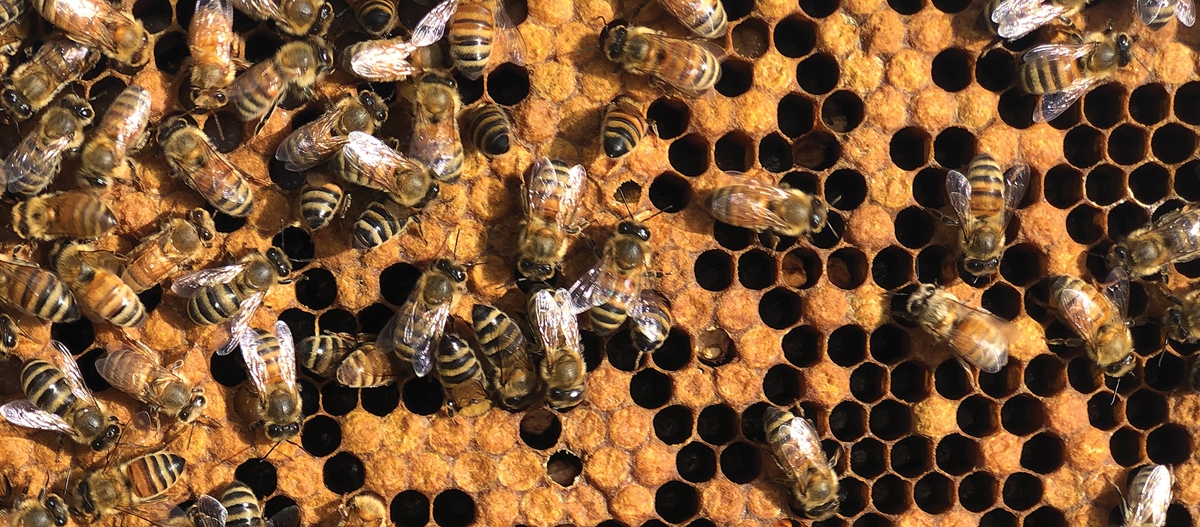I jumped into Bruce Auchly’s truck one sunny morning in late June. Heading east out of Great Falls toward the Little Belts, we were going to visit a site he calls Pleasant Valley, where he keeps some of his beehives.
We rolled by green fields of barley and wheat and past farmlands plush with clover and alfalfa just barely starting to bloom.
“Grains are no use to bees, because they don’t flower,” he said. “That’s part of the issue with the Golden Triangle north of Great Falls. I’ve got some hives up around Dutton, where there’s just too much grain and not enough flower.”
At that point in our drive, we had seen little evidence of much flowering, and it was unseasonably green for late June. “Everything is about two weeks late this year,” said Auchly.
Suddenly we came up over a hill overlooking a field busting out with purple blooms.

“That’s sainfoin—the holy hay—which is really great for bees,” he said.
Sainfoin is a forage crop, like alfalfa, that grows well in dryland agriculture. Some growers swear it produces better protein for cattle than alfalfa. According to Auchly, it’s not only better for cattle, it’s better for bees.
“You need to cut alfalfa right when it’s blooming, so the proteins stored in the plant get to the animal. But they let sainfoin flower for three weeks, which means your bees, instead of having just a few days to gather all the nectar, now have three weeks,” he said. “That’s a huge advantage if you can get your hives near a field of sainfoin.”
Auchly’s Paradise hives rest near these lush sainfoin fields, about a quarter mile as the bee flies.
We pulled off the main road onto some ruts that cut through a grass pasture. We came upon five towers of multicolored wooden boxes, stacked three-high and resting on wooden pallets.
Auchly considers himself a hobbyist, maintaining as many as 30 hives at three sites around the Great Falls area.
“It’s a lot to manage, taking as much as one day a week of my time during certain times of the year,” he said. “Somewhere between 20 and 30 hives is about the most I can handle with a day job, while trying to have other interests, like fishing or reading a book.”
Auchly’s day job is working as the regional Information Officer for the Montana Fish, Wildlife & Parks’ Region 4.
“The idea of keeping bees always interested me,” said Auchly. Both of his parents grew up on Missouri farms in the Depression era, when beekeeping was a common practice because it provided free sugar. Auchly noted that WWII also saw a boom in beekeeping, again to provide sugar that was, at the time, rationed.
“My dad’s family kept bees, and he told me stories about going out to catch swarms when he was a kid in the 30s.”
About 13 years ago, Auchly decided to take the first steps toward becoming a beekeeper himself. He attended an intro to beekeeping workshop. Meanwhile, a co-worker at the FWP, who was a beekeeper, offered to help him try his hand at producing honey.
“I got to take a class, and I had a mentor who worked down the hall from me. It was great,” said Auchy. “Everything worked well, like it was meant to BEEEEEEE!”
He decided beekeeping might be something he could do on a half-time basis in retirement and intended to amp up his operation, slowly over time.
“Well, when I do something, I usually go overboard and ruin everything,” he said. He quickly amassed his hive collection, and now he’s a got a cottage food permit, which allows him to sell his honey, face-to-face, at farmers markets around the state. Each of his hives produces, on average, 70 pounds of honey per year.

We zipped into our protective suits and started getting ready to inspect Auchly’s hives. He pulled out his bee smoker—a spouted metal can. He packed it full of blue denim, then lit the fabric and closed the lid.
He pumped the bellows affixed to the backside of the can, and smoke blew out the spout. He walked over to one of the stacked boxes, removed the lid, and began pumping smoke into the hive.
“Smoke calms the bees, but I’m not exactly sure why,” he said. “I’m not fond of getting stung in the face.
Auchly methodically looked into the boxes, each one filled with horizontally stacked frames.
He pulled out and inspected each frame, assessing its productivity. Some were completely bumbling over with worker bees that were busy feeding and sealing eggs into individual hexagon apartments.
“I’m trying to find one that’s full of brood, eggs that are sealed up,” he said.
Suddenly he got all giddy.
“Wow! Look at that!” He held up a frame that was loaded, each comb stuffed with a single white spec that looked like a grain of rice. “A productive queen can produce as many as 50 to 60 thousand eggs by mid-July. This queen is really laying eggs!”
Other frames did not appear to be thriving quite so well.
“Uh oh, this doesn’t look good,” said Auchly, scraping a pile of shavings outside the base of one of the boxes, (they looked like little black toenail clippings from my mini-pinscher). They were dead larvae the worker bees had cleaned out of the brood box.
It was a sign of chalkbrood, a fungal disease that infects larvae, especially during spring, when conditions are cool and wet. The infection can wipe out an entire colony if not managed properly.
Meanwhile, worker bees dump any debris outside the box in an effort to keep the comb cells clean for the queen. “Bees are fastidious,” he said.
Auchly treats his hives twice a year for mites and viruses, but he always accounts for significant losses every year.
“A lot of commercial beekeepers just bank on losing 20 to 30 percent of their bees every year,” he said. “In the state of Montana, bees are considered livestock. Can you imagine being a farmer or rancher and planning on losing up to a third of your crop or livestock every year? That’s pretty wild to think about!”
“An etymologist friend of mine once said you can either make honey, or you can make bees,” he said.
To make bees, Auchly explained, you need to build up your hives, replacing the old queens with new, more productive queens. Instead of having three really large hives, a beekeeper would go into winter with six smaller hives, creating greater opportunity for honey production the following year.
After assessing his hives, Auchly noted productivity was slightly less than his hives from the previous year, but he was far from discouraged.
“This just may be the year to make bees.” MSN










